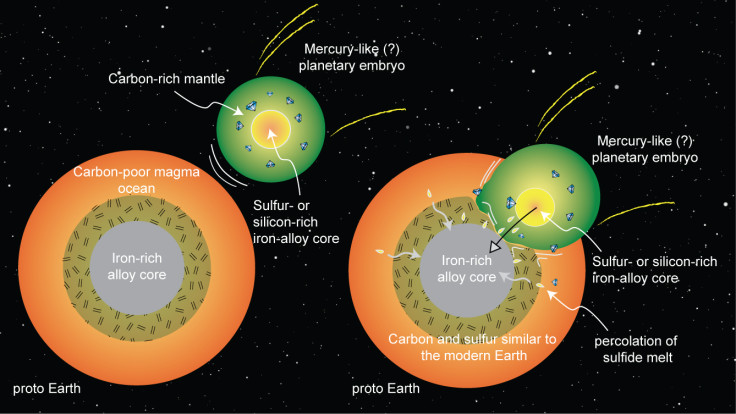Earth's carbon came from massive collision with Mercury-like planet 4.4 billion years ago
The element carbon is essential to the formation of life as we know it.

New research conducted Rice University scientists suggests that virtually all of the carbon on Earth – an element essential to life as we know it – could have come from a collision that occurred 4.4 billion years ago between our home and an embryonic, Mercury-like planet.
The study, published in the journal Nature Geoscience, offers new answers to the unsolved geological question of how carbon-based life developed on Earth, despite the traditional view held by scientists that most of the planet's carbon should have either boiled away in the planet's early history or become trapped in its core.
"The challenge is to explain the origin of the volatile elements like carbon that remain outside the core in the mantle portion of our planet," said Rice geologist Rajdeep Dasgupta, who co-authored the study with lead author and former Rice postdoctoral researcher Yuan Li, Rice research scientist Kyusei Tsuno and colleagues Brian Monteleone and Nobumichi Shimizu from Woods Hole Oceanographic Institute.
Dasgupta's lab specialises in recreating the high-pressure and high-temperature conditions that exist deep inside the Earth and other rocky planets. His team squeezes rocks in hydraulic presses that can simulate conditions about 250 miles below the Earth's surface.
"Even before this paper, we had published several studies that showed that even if carbon did not vaporize into space when the planet was largely molten, it would end up in the metallic core of our planet, because the iron-rich alloys there have a strong affinity for carbon," Dasgupta said.
The Earth's core, comprised mostly of iron, makes up around a third of the planet's mass. The mantle, which accounts for most of the other two-thirds, extends more than 1,500 miles below the surface and is made up mostly of silicate rock. The Earth's crust and atmosphere combined account for less than 1% of the planet's mass. The mantle, crust and atmosphere are locked in a continuous exchange of elements, including volatile elements that are crucial for life.

According to scientists, Earth's initial carbon should have boiled away into space or become trapped in the core. So where did the carbon in the mantle and biosphere – the layer of the planet where life exists – come from?
"One popular idea has been that volatile elements like carbon, sulphur, nitrogen and hydrogen were added after Earth's core finished forming," said Li. "Any of those elements that fell to Earth in meteorites and comets more than about 100 million years after the solar system formed could have avoided the intense heat of the magma ocean that covered Earth up to that point.
"The problem with that idea is that while it can account for the abundance of many of these elements, there are no known meteorites that would produce the ratio of volatile elements in the silicate mantle of our planet," he said.
So in 2013, Dasgupta and his colleagues decided to explore the issue of volatile elements and core composition and began to conduct experiments aimed at shining some light on the puzzle.
"One scenario that explains the carbon-to-sulphur ratio and carbon abundance is that an embryonic planet like Mercury, which had already formed a silicon-rich core, collided with and was absorbed by Earth," Dasgupta said. "Because it's a massive body, the dynamics could work in a way that the core of that planet would go directly to the core of our planet, and the carbon-rich mantle would mix with Earth's mantle.
"In this paper, we focused on carbon and sulphur," he said. "Much more work will need to be done to reconcile all of the volatile elements, but at least in terms of the carbon-sulphur abundances and the carbon-sulphur ratio, we find this scenario could explain Earth's present carbon and sulphur budgets."
© Copyright IBTimes 2024. All rights reserved.





